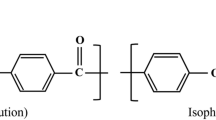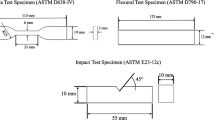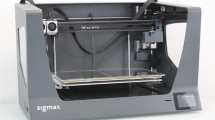Abstract
Polyether ketone ketone (PEKK) is a high-performance thermoplastic used in the fused filament fabrication (FFF) process to manufacture end use parts for the biomedical and aerospace industries. While other high-performance polymers such as polyetherimide (PEI) and polyether ether ketone (PEEK) have been studied extensively in literature, minimal studies have investigated the effects of FFF process parameters on PEKK. Tensile properties of FFF-printed PEKK was most affected by build orientation followed by number of contours in our previous study, although effects of build orientation on various properties of materials have been examined extensively, only few studies focused on number of contours. This study aims to understand if the selected parameters from our previous study affect other properties of PEKK, and if employing more contours can further improve these properties. A Taguchi orthogonal array varying contours in 4 levels and all other factors in 2 levels were used for this study. Optimum process parameters that maximize properties including compressive, flexural, thermomechanical, dynamic mechanical, and surface roughness were determined, and samples were printed using those settings to verify the statistical model. For the first time in literature, analysis was performed to understand if process parameters affected porosity and that, in turn, influenced mechanical properties. Comparison of flexural properties with injection-molded counterparts revealed that through optimization of process parameters, even the cost-effective printers used in this study could produce parts with properties almost equal to injection-molded parts in the direction of measurement. In addition, a coefficient of linear thermal expansion varied significantly with changes in process parameters and the variation was attributed mostly to porosity within samples and alignment of rasters with the direction of measurement. A clear relationship between number of contours, porosity, and mechanical properties was observed for most responses. Overall, number of contours was the most significant process parameter as more contours reduced porosity and improved mechanical and dynamic mechanical properties.

























Similar content being viewed by others
Data availability
The datasets generated during and/or analyzed during the current study are available from the corresponding author on reasonable request.
Code availability
This is not applicable.
References
Geoffroy L, Samyn F, Jimenez M, Bourbigot S (2019) Additive manufacturing of fire-retardant ethylene-vinyl acetate. Polym Adv Technol 30(7):1878–1890. https://doi.org/10.1002/pat.4620
Kumar N, Jain PK, Tandon P, Mohan Pandey P (2018) Experimental investigations on suitability of polypropylene (PP) and ethylene vinyl acetate (EVA) in additive manufacturing. Mater Today Proc 5(2_Part_1):4118–4127. https://doi.org/10.1016/j.matpr.2017.11.672
Caminero MÁ, Chacón JM, García-Plaza E, Núñez PJ, Reverte JM, Becar JP (2019) Additive manufacturing of PLA-based composites using fused filament fabrication: effect of graphene nanoplatelet reinforcement on mechanical properties, dimensional accuracy and texture. Polymers 11(5):799. https://doi.org/10.3390/polym11050799
Wach RA, Wolszczak P, Adamus-Wlodarczyk A (2018) Enhancement of mechanical properties of FDM-PLA parts via thermal annealing. Macromol Mater Eng 303(9):1800169. https://doi.org/10.1002/mame.201800169
Vicente CMS, Martins TS, Leite M, Ribeiro A, Reis L (2020) Influence of fused deposition modeling parameters on the mechanical properties of ABS parts. Polym Adv Technol 31(3):501–507. https://doi.org/10.1002/pat.4787
Onwubolu GC, Rayegani F (2014) Characterization and optimization of mechanical properties of abs parts manufactured by the fused deposition modelling process. Int J Manuf Eng 2014:598531. https://doi.org/10.1155/2014/598531
Leary M, Mazur M, Watson M, Boileau E, Brandt M (2019) Voxel-based support structures for additive manufacture of topologically optimal geometries. Int J Adv Manuf Technol 105(1):1–26. https://doi.org/10.1007/s00170-019-03964-z
Caminero MA, Caminero MA, Chacón JM, García-Moreno I, Reverte JM (2018) Interlaminar bonding performance of 3D printed continuous fibre reinforced thermoplastic composites using fused deposition modelling. Polym Test 68:415–423. https://doi.org/10.1016/j.polymertesting.2018.04.038
Zaldivar RJ, Witkin DB, McLouth T, Patel DN, Schmitt K, Nokes JP (2017) Influence of processing and orientation print effects on the mechanical and thermal behavior of 3D-Printed ULTEM ® 9085 Material. Addit Manuf 13:71–80. https://doi.org/10.1016/j.addma.2016.11.007
Ahn SH, Montero M, Odell D, Roundy S, Wright PK (2002) Anisotropic material properties of fused deposition modeling ABS. Rapid Prototyp 8(4):248–257
Garg A, Bhattacharya A, Batish A (2016) On surface finish and dimensional accuracy of FDM parts after cold vapor treatment. Mater Manuf Process 31(4):522–529. https://doi.org/10.1080/10426914.2015.1070425
Carneiro OS, Silva AF, Gomes R (2015) Fused deposition modeling with polypropylene. Mater Des 83:768–776. https://doi.org/10.1016/j.matdes.2015.06.053
Beniak J, Krizan P, Soos Lu, Matus M (2018) Roughness and compressive strength of FDM 3D printed specimens affected by acetone vapour treatment. IOP Conf Ser: Mater Sci Eng 297:012018/012011. https://doi.org/10.1088/1757-899x/297/1/012018
Rinaldi M, Ghidini T, Cecchini F, Brandao A, Nanni F (2018) Additive layer manufacturing of poly (ether ether ketone) via FDM. Compos B 145:162–172. https://doi.org/10.1016/j.compositesb.2018.03.029
Gibson I, Rosen D, Stucker B (2015) Additive manufacturing technologies 3D printing, rapid prototyping, and direct digital manufacturing, 2nd edn. Springer, New York
Wu W, Geng P, Li G, Zhao D, Zhang H, Zhao J (2015) Influence of layer thickness and raster angle on the mechanical properties of 3D-printed PEEK and a comparative mechanical study between PEEK and ABS. Materials (Basel) 8(9):5834–5846. https://doi.org/10.3390/ma8095271
Huang B, Masood S, Nikzad M, Venugopal PR, Arivazhagan A (2016) Dynamic mechanical properties of fused deposition modelling processed polyphenylsulfone material. Am J Eng Appl Sci 9:1–11
Vyavahare S, Kumar S, Panghal D (2020) Experimental study of surface roughness, dimensional accuracy and time of fabrication of parts produced by fused deposition modelling. Rapid Prototyp 26(9):1535–1554. https://doi.org/10.1108/RPJ-12-2019-0315
Reddy V, Flys O, Chaparala A, Berrimi CE, V A, Rosen BG (2018) Study on surface texture of fused deposition modeling. Procedia Manuf 25:389–396. https://doi.org/10.1016/j.promfg.2018.06.108
Ding S, Zou B, Wang P, Ding H (2019) Effects of nozzle temperature and building orientation on mechanical properties and microstructure of PEEK and PEI printed by 3D-FDM. Polym Test 78. https://doi.org/10.1016/j.polymertesting.2019.105948
Sood AK, Ohdar RK, Mahapatra SS (2010) Parametric appraisal of mechanical property of fused deposition modelling processed parts. Mater Des 31(1):287–295. https://doi.org/10.1016/j.matdes.2009.06.016
Gopi Mohan R, Santhosh K, Iyer RV, John LK, Ramu M (2021) Comparitive analysis of mechanical properties of FDM printed parts based on raster angles. Mater Today Proc 47(Part_14):4730–4734. https://doi.org/10.1016/j.matpr.2021.05.649
Gebisa AW, Lemu HG (2018) Investigating effects of fused-deposition modeling (FDM) Processing parameters on flexural properties of ULTEM 9085 using designed experiment. Materials (Basel) 11 (4). https://doi.org/10.3390/ma11040500
Pandelidi C, Maconachie T, Bateman S, Kelbassa I, Piegert S, Leary M, Brandt M (2021) Parametric study on tensile and flexural properties of ULTEM 1010 specimens fabricated via FDM. Rapid Prototyp J 27(2):429–451. https://doi.org/10.1108/RPJ-10-2019-0274
Mostafa KG, Montemagno C, Qureshi AJ (2018) Strength to cost ratio analysis of FDM Nylon 12 3D Printed Parts. Procedia Manuf 26:753–762. https://doi.org/10.1016/j.promfg.2018.07.086
Xu C, Cheng K, Liu Y, Wang R, Jiang X, Dong X, Xu X (2021) Effect of processing parameters on flexural properties of 3D-printed polyetherketoneketone using fused deposition modeling. Polym Eng Sci 61(2):465–476. https://doi.org/10.1002/pen.25590
Gebisa AW, Lemu HG (2018) Effect of process parameters on compressive properties of ULTEM 9085 produced by FDM process. In: ASME 2018 International Mechanical Engineering Congress and Exposition IMECE2018, Pittsburgh, PA, USA, 2018
Aloyaydi B, Sivasankaran S, Mustafa A (2020) Investigation of infill-patterns on mechanical response of 3D printed poly-lactic-acid. Polym Test 87:106557. https://doi.org/10.1016/j.polymertesting.2020.106557
Mohamed OA, Masood SH, Bhowmik JL, Nikzad M, Azadmanjiri J (2016) Effect of process parameters on dynamic mechanical performance of FDM PC/ABS printed parts through design of experiment. J Mater Eng Perform 25(7):2922–2935. https://doi.org/10.1007/s11665-016-2157-6
Han J-H, Kim C-G (2006) Low earth orbit space environment simulation and its effects on graphite/epoxy composites. Compos Struct 72(2):218–226. https://doi.org/10.1016/j.compstruct.2004.11.007
Fitzharris E, Watanabe N, Rosen D, Shofner M (2018) Effects of material properties on warpage in fused deposition modeling parts. Int J Adv Manuf Technol 95(5):2059–2070. https://doi.org/10.1007/s00170-017-1340-8
Thornton E (1996) Thermal structures for aerospace applications. American Institute of Aeronautics and Astronautics, Reston
Love LJ, Kunc V, Rios O, Duty CE, Elliott AM, Post BK, Smith RJ, Blue CA (2014) The importance of carbon fiber to polymer additive manufacturing. J Mater Res 29(17):1893–1898. https://doi.org/10.1557/jmr.2014.212
Dul S, Fambri L, Pegoretti A (2016) Fused deposition modelling with ABS-graphene nanocomposites. Compos A 85:181–191. https://doi.org/10.1016/j.compositesa.2016.03.013
Arif MF, Arif MF, Alhashmi H, Varadarajan KM, Koo JH, Hart AJ, Kumar S (2020) Multifunctional performance of carbon nanotubes and graphene nanoplatelets reinforced PEEK composites enabled via FFF additive manufacturing. Composites 184:107625. https://doi.org/10.1016/j.compositesb.2019.107625
Economidou SN, Karalekas D (2016) Optical sensor-based measurements of thermal expansion coefficient in additive manufacturing. Polym Test 51:117–121. https://doi.org/10.1016/j.polymertesting.2016.03.001
Kantaros A, Karalekas D (2013) Fiber Bragg grating based investigation of residual strains in ABS parts fabricated by fused deposition modeling process. Mater Des 1980–2015(50):44–50. https://doi.org/10.1016/j.matdes.2013.02.067
Chuang KC, Grady JE, Draper RD, Shin E-SE, Patterson C, Santelle TD (2015) Additive manufacturing and characterization of Ultem polymers and composites. Paper presented at the CAMX, Dallas, TX
He Q, Wang H, Fu K, Ye L (2020) 3D printed continuous CF/PA6 composites: Effect of microscopic voids on mechanical performance. Compos Sci Technol 191:108077. https://doi.org/10.1016/j.compscitech.2020.108077
Wang X, Zhao L, Fuh JYH, Lee HP (2019) Effect of porosity on mechanical properties of 3d printed polymers: experiments and micromechanical modeling based on X-ray computed tomography analysis. Polymers (Basel, Switz) 11 (7). https://doi.org/10.3390/polym11071154
Lepoivre A, Levy A, Boyard N, Gaudefroy V, Sobotka V (2021) Coalescence in fused filament fabrication process: thermo-dependent characterization of high-performance polymer properties. Polym Test 98(107096):107096. https://doi.org/10.1016/j.polymertesting.2021.107096
Li B, Yang J, Gu H, Jiang J, Zhang J, Sun J (2021) Surface roughness of PLA parts by FDM with chemical treatment. J Phys: Conf Ser 1948:012199. https://doi.org/10.1088/1742-6596/1948/1/012199
Giri J, Shahane P, Jachak S, Chadge R, Giri P (2021) Optimization of FDM process parameters for dual extruder 3D printer using artificial neural network. Mater Today: Proc 43(Part_5):3242–3249. https://doi.org/10.1016/j.matpr.2021.01.899
Altan M (2018) Effects of process parameters on the quality of PLA products fabricated by fused deposition modeling (FDM): surface roughness and tensile strength. Mater Test 60(5):471–477. https://doi.org/10.3139/120.111178
Wang P, Zou B, Xiao H, Ding S, Huang C (2019) Effects of printing parameters of fused deposition modeling on mechanical properties, surface quality, and microstructure of PEEK. J Mater Process Technol 271:62–74. https://doi.org/10.1016/j.jmatprotec.2019.03.016
Cheng K-J, Liu Y-F, Wang R, Zhang J-X, Jiang X-F, Dong X-T, Xu X (2020) Topological optimization of 3D printed bone analog with PEKK for surgical mandibular reconstruction. J Mech Behav Biomed Mater 107:103758. https://doi.org/10.1016/j.jmbbm.2020.103758
Lommen J, Schorn L, Sproll C, Haussmann J, Kübler NR, Budach W, Rana M, Tamaskovics B (2022) Reduction of CT artifacts using polyetheretherketone (PEEK), polyetherketoneketone (PEKK), polyphenylsulfone (PPSU), and polyethylene (PE) reconstruction plates in oral oncology. J Oral Maxillofac Surg 80(7):1272–1283. https://doi.org/10.1016/j.joms.2022.03.004
Mazur RL (2008) Thermal and rheological evaluation of PEKK thermoplastics for aeronautical applications. Polímeros, ciência e tecnologia 18(3):237–243
Auletti CR, Martino AJ, Sheinman OR (2016) Mission of firsts. National Aeronautics and Space Administration Cutting Edge, vol 12. NASA, USA
Choupin T (2017) Mechanical performances of PEKK thermoplastic composites linked to their processing parameters. Paris Institute of Technology, Français
Reber Iii R, Koo B, Liu D (2019) Polyetherketoneketone (PEKK), a Versatile ultra-polymer for additive manufacturing. Paper presented at the SAMPE 2019 - Charlotte, NC
Rashed K, Kafi A, Simons R, Bateman S (2022) Effects of fused filament fabrication process parameters on tensile properties of polyether ketone ketone (PEKK). Int J Adv Manuf Technol 122:3607–3621. https://doi.org/10.1007/s00170-022-10134-1
Boursier Niutta C, Ciardiello R, Tridello A (2022) Experimental and numerical investigation of a lattice structure for energy absorption: application to the design of an automotive crash absorber. Polymers 14 (6). https://doi.org/10.3390/polym14061116
Mishra AK, Chavan H, Kumar A (2021) Effect of material variation on the uniaxial compression behavior of FDM manufactured polymeric TPMS lattice materials. Mater Today: Proc 46:7752–7759. https://doi.org/10.1016/j.matpr.2021.02.276
Rashed K, Kafi A, Simons R, Bateman S (2022) Fused filament fabrication of nylon 6/66 copolymer: parametric study comparing full factorial and Taguchi design of experiments. Rapid Prototyp J 28(6):1111–1128. https://doi.org/10.1108/RPJ-06-2021-0139
Huang B, Singamneni S (2014) Raster angle mechanics in fused deposition modelling. J Compos Mater 49(3):363–383. https://doi.org/10.1177/0021998313519153
Kiendl J, Gao C (2020) Controlling toughness and strength of FDM 3D-printed PLA components through the raster layup. Compos B 180:107562. https://doi.org/10.1016/j.compositesb.2019.107562
Ginting E, Tambunan MM (2018) Selection of optimal factor level from process parameters in palm oil industry. IOP Conf Ser Mater Sci Eng 288:012056. https://doi.org/10.1088/1757-899x/288/1/012056
Nano Polymer Adhesive (2021) Vision Miner. https://visionminer.com/products/nano-polymer-adhesive. Accessed 2 Jun 2022
Friedrich K, Evstatiev M, Fakirov S, Evstatiev O, Ishii M, Harrass M (2004) Microfibrillar reinforced composites from PET/PP blends: processing, morphology and mechanical properties. Compos Sci Technol 65(1):107–116. https://doi.org/10.1016/j.compscitech.2004.06.008
ASTM (2017) ASTM D790–03 standard test methods for flexural properties of unreinforced and reinforced plastics and electrical insulating materials. ASTM Int. https://doi.org/10.1520/D0790-03
ASTM (2016) ASTM D695–15 standard test method for compressive properties of rigid plastics. ASTM. https://doi.org/10.1520/D0695-15
ASTM (2020) ASTM D4065–20 Standard practice for plastics: dynamic mechanical properties: determination and report of procedures. ASTM Int. https://doi.org/10.1520/D4065-20
Menczel JD, Prime RB (2009) Thermal analysis of polymers: fundamentals and applications, 1st edn. Wiley, Hoboken
ASTM (2019) ASTM E831–19 standard test method for linear thermal expansion of solid materials by thermomechanical analysis. ASTM. https://doi.org/10.1520/E0831-19
He YX, Sang YF, Zhang L, Yao DH, Sun KB, Zhang YQ (2014) Coefficient of thermal expansion and mechanical properties at cryogenic temperature of core-shell rubber particle modified epoxy. Plast Rubber Compos 43(3):89–97. https://doi.org/10.1179/1743289814Y.0000000074
Lanzotti A, Grasso M, Staiano G, Martorelli M (2015) The impact of process parameters on mechanical properties of parts fabricated in PLA with an open-source 3-D printer. Rapid Prototyp J 21(5):604–617. https://doi.org/10.1108/RPJ-09-2014-0135
Chacón JM, Caminero MA, García-Plaza E, Núñez PJ (2017) Additive manufacturing of PLA structures using fused deposition modelling: effect of process parameters on mechanical properties and their optimal selection. Mater Des 124:143–157. https://doi.org/10.1016/j.matdes.2017.03.065
Tymrak BM, Kreiger M, Pearce JM (2014) Mechanical properties of components fabricated with open-source 3-D printers under realistic environmental conditions. Mater Des 58:242–246. https://doi.org/10.1016/j.matdes.2014.02.038
Quero RF, Domingos da Silveira G, Fracassi da Silva JA, Jesus DPd (2021) Understanding and improving FDM 3D printing to fabricate high-resolution and optically transparent microfluidic devices. Lab Chip 21(19):3715–3729. https://doi.org/10.1039/D1LC00518A
Rashed K, Kafi A, Simons R, Bateman S (2022) Fused filament fabrication of nylon 6/66 copolymer: parametric study comparing full factorial and Taguchi design of experiments. Rapid Prototyp J ahead-of-print (ahead-of-print). https://doi.org/10.1108/RPJ-06-2021-0139
Li Q, Zhao W, Li Y, Yang W, Wang G (2019) Flexural properties and fracture behavior of CF/PEEK in orthogonal building orientation by FDM: microstructure and mechanism. Polymers 11 (4). https://doi.org/10.3390/polym11040656
Ding S, Zou B, Wang P, Ding H (2019) Effects of nozzle temperature and building orientation on mechanical properties and microstructure of PEEK and PEI printed by 3D-FDM. Polym Test 78:105948. https://doi.org/10.1016/j.polymertesting.2019.105948
Durgun I, Ertan R (2014) Experimental investigation of FDM process for improvement of mechanical properties and production cost. Rapid Prototyp J 20(3):228–235. https://doi.org/10.1108/RPJ-10-2012-0091
Vaes D, Van Puyvelde P (2021) Semi-crystalline feedstock for filament-based 3D printing of polymers. Progress Polym Sci 118:101411. https://doi.org/10.1016/j.progpolymsci.2021.101411
Sun Q, Shan Z, Zhan L, Wang S, Liu X, Li Z, Wu S (2021) Warp deformation model of polyetheretherketone composites reinforced with carbon fibers in additive manufacturing. Mater Res Express 8(12):125305. https://doi.org/10.1088/2053-1591/abeec8
Menard KP (2008) Time and temperature scans part i transitions in polymers. In. CRC Press, pp 115–142. https://doi.org/10.1201/9781420053135-12
Colon Quintana JL, Redmann A, Mazzei Capote GA, Perez-Irizarry A, Bechara A, Osswald TA, Lakes R (2019) Viscoelastic properties of fused filament fabrication parts. Addit Manuf 28:704–710. https://doi.org/10.1016/j.addma.2019.06.003
Chen L, Zhang X, Gan S (2020) Effects of laser polishing on surface quality and mechanical properties of PLA parts built by fused deposition modeling. J Appl Polym Sci 137(3):48288. https://doi.org/10.1002/app.48288
Chen L, Zhang X, Wang Y, Osswald TA (2020) Laser polishing of Cu/PLA composite parts fabricated by fused deposition modeling: analysis of surface finish and mechanical properties. Polym Compos 41(4):1356–1368. https://doi.org/10.1002/pc.25459
Hatta H, Takei T, Taya M (2000) Effects of dispersed microvoids on thermal expansion behavior of composite materials. Mater Sci Eng A Struct Mater Prop Microstruct Process 285(1):99–110. https://doi.org/10.1016/S0921-5093(00)00721-8
Heathman N, Yap T, Tehrani M (2020) Hot isostatic pressing to enhance inter-laminar tensile strength in additively manufactured carbon fiber-PEEK parts. In: 35th Annual American Society for Composites Technical Conference, ASC 2020. DEStech Publications, pp 97–106
Mohamed OA, Masood SH, Bhowmik JL (2017) Experimental investigation of creep deformation of part processed by fused deposition modeling using definitive screening design. Addit Manuf 18:164–170. https://doi.org/10.1016/j.addma.2017.10.013
Sun Q, Rizvi GM, Bellehumeur CT, Gu P (2008) Effect of processing conditions on the bonding quality of FDM polymer filaments. Rapid Prototyp J 14(2):72–80. https://doi.org/10.1108/13552540810862028
Hopkins PE, Holzwarth DJ (2011) Seam concealment for three-dimensional models. US20110070394
Nidagundi VB, Nidagundi V, Keshavamurthy R, Prakash CPS (2015) Studies on parametric optimization for fused deposition modelling process. Mater Today Proc 2(4–5):1691–1699. https://doi.org/10.1016/j.matpr.2015.07.097
Sandhu GS, Boparai KS, Sandhu KS (2022) Effect of slicing parameters on surface roughness of fused deposition modeling prints. Mater Today: Proc 48(Part_5):1339–1345. https://doi.org/10.1016/j.matpr.2021.09.047
Materials Database (2022) Arkema. https://hpp.arkema.com/en/materials-database/products/datasheet/Kepstan%C2%AE%206002. Accessed 13 Jun 2022
Acknowledgments
The authors acknowledge the facilities and technical assistance of Advanced Manufacturing Precinct, Process Chemistry and Environmental Technical Services, Analytical Chemistry, and Australian Microscopy and Microanalysis Facility, all of which are part of RMIT University Melbourne City Campus.
Funding
This study was funded by the Australian Government Research Training Program Scholarship and The Commonwealth Scientific and Industrial Research Organisation (CSIRO).
Author information
Authors and Affiliations
Contributions
All authors contributed to the study conception and design. 3D printing was performed by Kaifur Rashed and Abdullah Kafi. Data collection, analysis, and preparation of first draft were performed by Kaifur Rashed. All authors commented on previous versions of the manuscript. All authors read and approved the final manuscript.
Corresponding author
Ethics declarations
Ethics approval
This is not applicable.
Consent to participate
This is not applicable.
Consent for publication
This is not applicable.
Competing interests
The authors declare no competing interests.
Additional information
Publisher's Note
Springer Nature remains neutral with regard to jurisdictional claims in published maps and institutional affiliations.
Rights and permissions
Springer Nature or its licensor (e.g. a society or other partner) holds exclusive rights to this article under a publishing agreement with the author(s) or other rightsholder(s); author self-archiving of the accepted manuscript version of this article is solely governed by the terms of such publishing agreement and applicable law.
About this article
Cite this article
Rashed, K., Kafi, A., Simons, R. et al. Optimization of material extrusion additive manufacturing process parameters for polyether ketone ketone (PEKK). Int J Adv Manuf Technol 126, 1067–1091 (2023). https://doi.org/10.1007/s00170-023-11167-w
Received:
Accepted:
Published:
Issue Date:
DOI: https://doi.org/10.1007/s00170-023-11167-w




